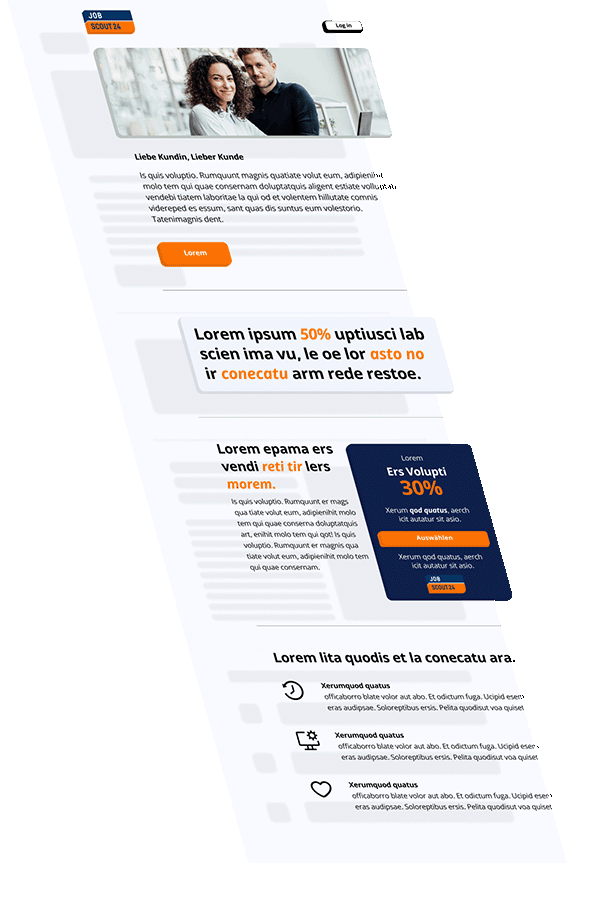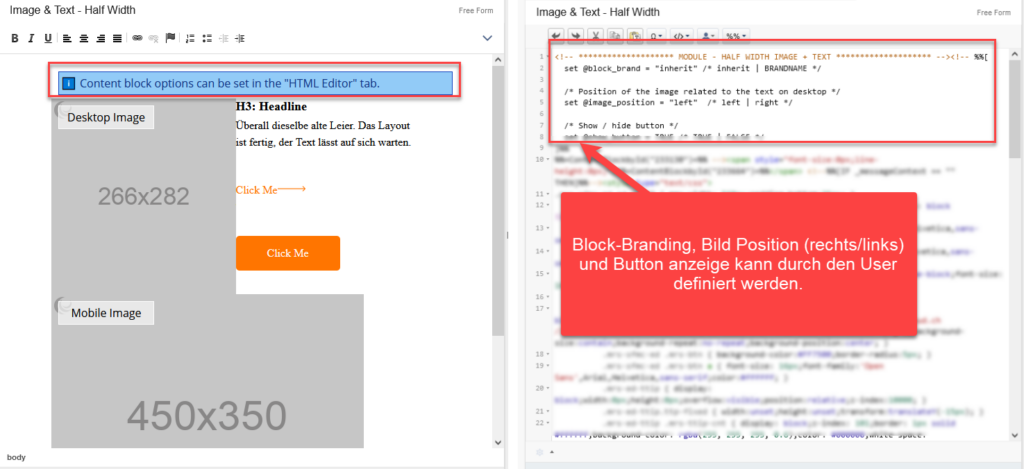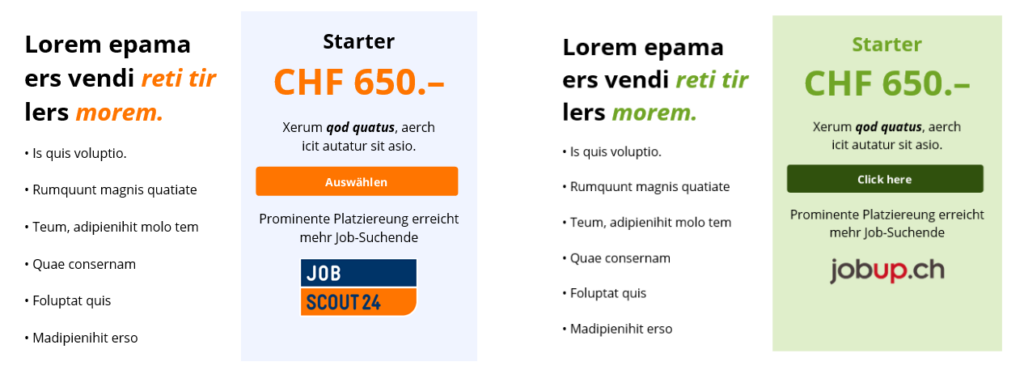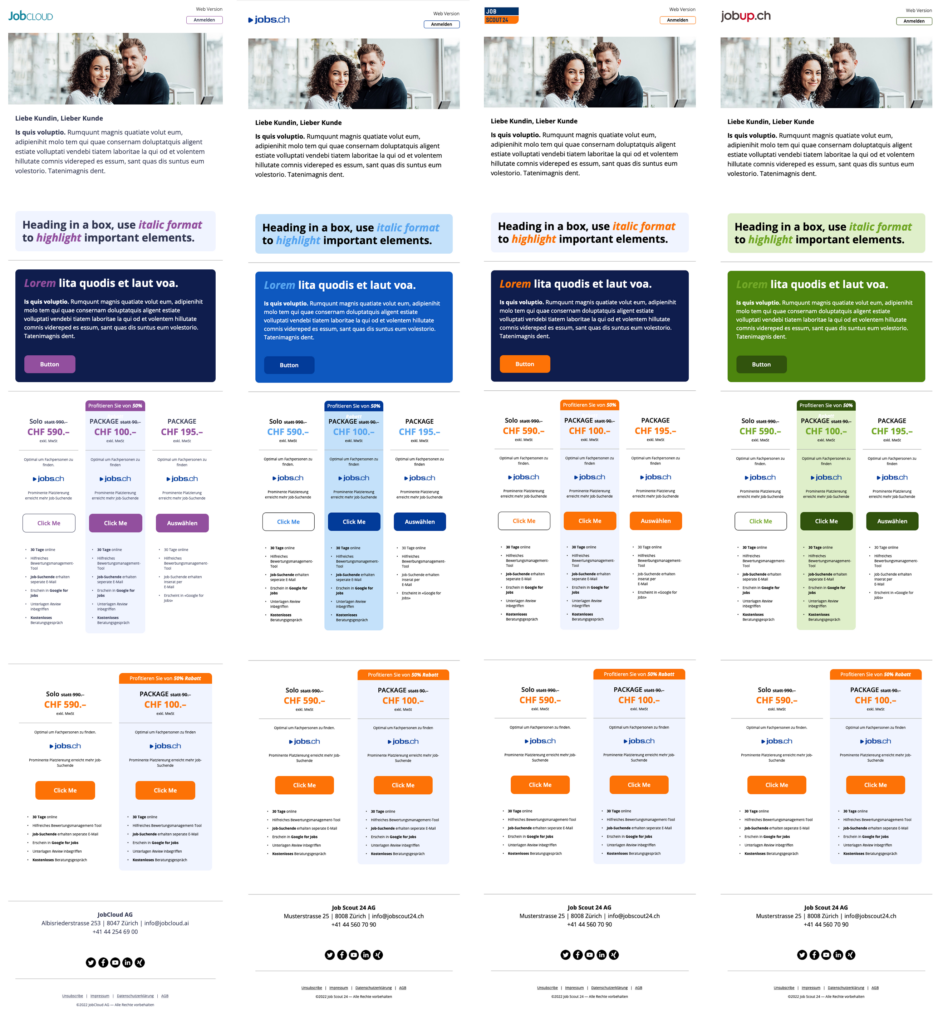Initial situation
Multiple brands, multiple email templates
Companies that offer products or services under several production or trade brands often face a problem with regard to e-mail communication: the structure of the communication media, especially in the digital area, is standardized, and the differentiation is primarily made through colors, fonts and visual language. In most marketing systems, a separate variant of the e-mail template must be implemented for each brand (and language). This leads to a multiplication of the effort during the initial setup, in the daily application, but also especially during maintenance.
Example: Jobcloud
The company offers the service (platform for personnel and job seekers) in 11 different brands. Each brand communicates in two to four languages (German, French, English, Italian).
According to the conventional approach, more than 30 variants of the e-mail template are required to cover all brand/language combinations, even though the structure of the communication has been standardized across all brands.
Adaptations to the e-mail templates caused by changes in e-mail clients and user behavior, e.g. currently due to the emergence of dark mode, result in high costs because a large number of templates have to be revised.
Solution approach
Multibrand template
Mayoris has developed the concept of the Multibrand E-Mail Template. The template is designed to implement a uniform layout for all brands centrally and to control which brand is applied when an e-mail is created or even when the e-mail is sent, based on parameters.

To achieve this, all customizable (“brandable”) properties of the template such as colors, fonts, font sizes, font styles, logos, and, if required, size specifications for content areas and spacing are stored as variables (or merge tags) in the source code of the template.
Die Werte für die Variablen werden durch die im MarTech System jeweils eingesetzte Scriptsprache festgelegt und im Versandprozess auf die E-Mail appliziert.
In the multibrand template, four different brands were integrated into a common multibrand template. The control of the individual brands can either be stored on the individual article or applied to the entire mailing.
This also makes it possible for individual items to be identified in the mailing in another branding and the template can be used even more flexibly.
Implementation in the Salesforce Marketing CloudEine Marketing Cloud Technologie umfasst verschiedene Module für die aktive Bewirtschaftung und Dialogführung von Kunden über eine digitale Marketing Plattform, welche selbst als SaaS-Dienstleistung - also über das Internet und nicht proprietär im eigenen...
Brand control
In the Salesforce Marketing Cloud, the implementation is done via AMPScript. AMPScript variables are integrated in the source code of the template. The values to be applied are loaded from a data extension based on the “Send Classification” selected during dispatch.
Content via content blocks
To ensure the flawless application of the branding, all content elements are implemented as content blocks of the type “Free Form”. This makes it possible to store the specifically required source code, including AMPScript, while at the same time allowing editors to edit the content in the WYSIWIG editor.
In order to facilitate the work of the editors, a “default” branding is applied via CSS played out exclusively in the editor and the preview and, if required, information boxes with additional information are displayed.

Use across multiple instances
If an individual Salesforce Marketing CloudEine Marketing Cloud Technologie umfasst verschiedene Module für die aktive Bewirtschaftung und Dialogführung von Kunden über eine digitale Marketing Plattform, welche selbst als SaaS-Dienstleistung - also über das Internet und nicht proprietär im eigenen... instance is used for each brand, content (template, content blocks) as well as the data extensions for storing the branding variables and AMPScript resources can be opened in the “shared” scope and are thus available to all connected instances. Which brand can be used in which instance is controlled granularly by defining the send classification for each instance.
Special feature: Block-level branding
As a special feature for Jobcloud, we have also integrated the ability to display individual content blocks in a specific brand, even if the email is sent in the context of another brand. This is helpful, for example, when offers for multiple platforms are to be sent in the context of the DACH brand.

Expansion option: Recipient-specific branding
In the current implementation variant, branding is based on the selected send classification. However, the multi-branding functionality is designed in such a way that it will be possible at a later stage to control the branding on the basis of the individual recipients. For this purpose, a corresponding brand assignment must exist for each recipient, e.g. on the subscriber profile or in the data extension used for sending.
This method is particularly useful for companies with a strong offer structure, such as issuers of credit cards (card brands and card colors) or loyalty programs (member status), as it is no longer necessary to set up separate e-mails for each card color or status (e.g. silver/gold/platinum).
Benefit
Efficient setup
The construction of the initial template with the first brand is more complex, since the entire variable structure and the functionality of the variable application must be created. However, the additional costs of each additional brand are significantly lower compared to the conventional approach, since only branding variables have to be stored in the data extension and the mapping table. As a rule, HTML adaptations are no longer necessary after the second brand. Exceptions are at most strongly deviating header and footer areas, which cannot be controlled or filled via variables.
Low costs for expansion and maintenance
The greatest efficiency gains are seen in the addition of new content elements to the existing template. If a new display element is required, only a new content block needs to be added, which in turn integrates the existing branding variables. This means that, regardless of the number of brands and variants, the content block only has to be implemented once and, in theory, only tested once.
The same applies to changes to the existing template and individual content blocks. These can be made centrally and are applied to all brands at the same time. This saves a lot of effort.
Cross-brand emails
The multibranding approach makes it possible in the implementation of campaigns to send an e-mail to recipient lists of several brands without having to create the e-mail several times. By applying the brand at the time of sending, the e-mail can be sent to combined lists with recipients of different brands / variants or the e-mail is sent several times (as a 1:1 copy) to different groups of recipients using the respective send classification per brand. This significantly simplifies the work of editors in the email creation process, as the content only needs to be filled and tested once. Once the content, images and links have been finally approved, a simple visual check is all that is needed to verify the various brands.

Multilanguage
AMPScript & Impression region instead of multiple emails
In most MarTech systems, a separate email must be created for each language in which the email is sent. However, in Salesforce Marketing Cloud, we use the power of AMPScript and Impression Regions to create a multi-language template.
AMPScript: Language-specific targeting per recipient
In order to be able to show each recipient only the content that was written in their personal language, the language areas of the template are played out for each recipient using AMPScript IF statements.
Impression regions for evaluation
The use of an impression region per language enables the evaluation of the email KPI (clicks, conversions) in the Salesforce Marketing CloudEine Marketing Cloud Technologie umfasst verschiedene Module für die aktive Bewirtschaftung und Dialogführung von Kunden über eine digitale Marketing Plattform, welche selbst als SaaS-Dienstleistung - also über das Internet und nicht proprietär im eigenen... across all languages as well as individually per language. This means that the overall performance of the campaign can be evaluated conveniently and efficiently for all languages as well as for each individual language. This is an extremely important factor for campaign follow-up.
Conclusion
A multilingual multibrand template greatly simplifies the creation of emails in Salesforce Marketing CloudEine Marketing Cloud Technologie umfasst verschiedene Module für die aktive Bewirtschaftung und Dialogführung von Kunden über eine digitale Marketing Plattform, welche selbst als SaaS-Dienstleistung - also über das Internet und nicht proprietär im eigenen... for companies with multiple production or retail brands. The email creation process can be made more efficient thanks to a standardized layout, central management of the brands and “late customization” when sending. In addition, the costs for extension and maintenance are significantly reduced, as only one central code and variable base needs to be edited and tested. Time-consuming alignment, rollout and test processes across the various brands are almost completely eliminated.


